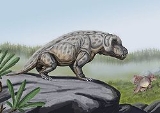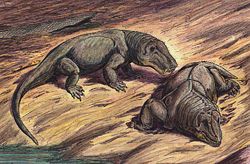
Anteosauridae
Encyclopedia
The Anteosauridae or Anteosaurinae are a family
(e.g. Boonstra 1963, 1969, Carroll 1988) or subfamily (e.g. Hopson & Barghusen 1986, King 1988) of very large carnivorous
Dinocephalia
(Anteosaur
s) that are known from the Middle Permian of Russia (Doliosauriscus
, Titanophoneus
) and South Africa (Anteosaurus
). The Russian genera were previously included by Efremov in the Brithopodidae
.
They are characterised by very large pointed incisor
s and canines
, bulbous spatulate (spoon shaped) postcanines, a very strongly upturned margin of the premaxilla
, so the front of mouth curves strongly upwards, and a long very robust lower jaw (Boonstra 1963).
 The Anteosauridae or Anteosaurinae are distinguished from more primitive Brithopodids
The Anteosauridae or Anteosaurinae are distinguished from more primitive Brithopodids
by the presence of a large thickened region or "boss" on the side of the angle of the lower jaw; this was probably used used in intraspecific behaviour. In Doliosauriscus
and Anteosaurus
, not only was this boss very prominent, but the bones were very thick and rugose. The same situation is found in the herbivorous Tapinocephalidae
, and it can be assumed that these animals engaged in head-butting behaviour. (Hopson & Barghusen 1986)
These animals were by far the largest predators of the Permian
period, with skulls reaching 80 cm in length in adult individuals, far larger than the biggest gorgonopsia
n.
Family (biology)
In biological classification, family is* a taxonomic rank. Other well-known ranks are life, domain, kingdom, phylum, class, order, genus, and species, with family fitting between order and genus. As for the other well-known ranks, there is the option of an immediately lower rank, indicated by the...
(e.g. Boonstra 1963, 1969, Carroll 1988) or subfamily (e.g. Hopson & Barghusen 1986, King 1988) of very large carnivorous
Carnivore
A carnivore meaning 'meat eater' is an organism that derives its energy and nutrient requirements from a diet consisting mainly or exclusively of animal tissue, whether through predation or scavenging...
Dinocephalia
Dinocephalia
Dinocephalia are a clade of large early therapsids that flourished during the Middle Permian, but became extinct leaving no descendants.-Description:...
(Anteosaur
Anteosaur
Anteosaurs are a group of large, primitive carnivorous Dinocephalians , with huge canines and incisors and short limbs, that are known from the Middle Permian of South Africa, Russia, and China. The largest grew to very large size, with skulls 50 to 80 cm long, and were the largest predators...
s) that are known from the Middle Permian of Russia (Doliosauriscus
Doliosauriscus
Doliosauriscus is an extinct genus of dinocephalian therapsid that lived in Russia during the mid-Permian Period. It was a large carnivore, its skull measuring 53 centimeters long.thumb|left|200px...
, Titanophoneus
Titanophoneus
Titanophoneus potens was a carnivorous Therapsid of the Dinocephalia group related to the Estemmenosuchidae, but living 5 million years later than Estemmenosuchus, during the Late Permian. Remains of this animal have been found at Isheevo in RussiaAn adult skull would have reached 80 cm with a...
) and South Africa (Anteosaurus
Anteosaurus
Anteosaurus is the name given to an extinct genus of large carnivorous synapsid. It lived during the Capitanian epoch of the Middle Permian in what is now South Africa...
). The Russian genera were previously included by Efremov in the Brithopodidae
Brithopodidae
Brithopodidae are a paraphyletic family of primitive mostly carnivorous Dinocephalians known from the Middle Permian of Russia. Nowadays the name is used less often, being replaced by Anteosauria Brithopodidae are a paraphyletic family of primitive mostly carnivorous Dinocephalians known from the...
.
They are characterised by very large pointed incisor
Incisor
Incisors are the first kind of tooth in heterodont mammals. They are located in the premaxilla above and mandible below.-Function:...
s and canines
Canine tooth
In mammalian oral anatomy, the canine teeth, also called cuspids, dogteeth, fangs, or eye teeth, are relatively long, pointed teeth...
, bulbous spatulate (spoon shaped) postcanines, a very strongly upturned margin of the premaxilla
Premaxilla
The incisive bone is the portion of the maxilla adjacent to the incisors. It is a pair of small cranial bones at the very tip of the jaws of many animals, usually bearing teeth, but not always. They are connected to the maxilla and the nasals....
, so the front of mouth curves strongly upwards, and a long very robust lower jaw (Boonstra 1963).

Brithopodidae
Brithopodidae are a paraphyletic family of primitive mostly carnivorous Dinocephalians known from the Middle Permian of Russia. Nowadays the name is used less often, being replaced by Anteosauria Brithopodidae are a paraphyletic family of primitive mostly carnivorous Dinocephalians known from the...
by the presence of a large thickened region or "boss" on the side of the angle of the lower jaw; this was probably used used in intraspecific behaviour. In Doliosauriscus
Doliosauriscus
Doliosauriscus is an extinct genus of dinocephalian therapsid that lived in Russia during the mid-Permian Period. It was a large carnivore, its skull measuring 53 centimeters long.thumb|left|200px...
and Anteosaurus
Anteosaurus
Anteosaurus is the name given to an extinct genus of large carnivorous synapsid. It lived during the Capitanian epoch of the Middle Permian in what is now South Africa...
, not only was this boss very prominent, but the bones were very thick and rugose. The same situation is found in the herbivorous Tapinocephalidae
Tapinocephalidae
Tapinocephalidae is an advanced family of tapinocephalians. They were all herbivores. They were giants of their time, weighing from 500 to 1000 kg and possibly over 1 or 2 tonnes in weight. They are known from South Africa and Russia. The tapinocephalid skull is very thick, probably used for...
, and it can be assumed that these animals engaged in head-butting behaviour. (Hopson & Barghusen 1986)
These animals were by far the largest predators of the Permian
Permian
The PermianThe term "Permian" was introduced into geology in 1841 by Sir Sir R. I. Murchison, president of the Geological Society of London, who identified typical strata in extensive Russian explorations undertaken with Edouard de Verneuil; Murchison asserted in 1841 that he named his "Permian...
period, with skulls reaching 80 cm in length in adult individuals, far larger than the biggest gorgonopsia
Gorgonopsia
Gorgonopsia is a suborder of therapsid synapsids. Their name is a reference to the Gorgons of Greek mythology. Like other therapsids, gorgonopsians were at one time called "mammal-like reptiles"...
n.

